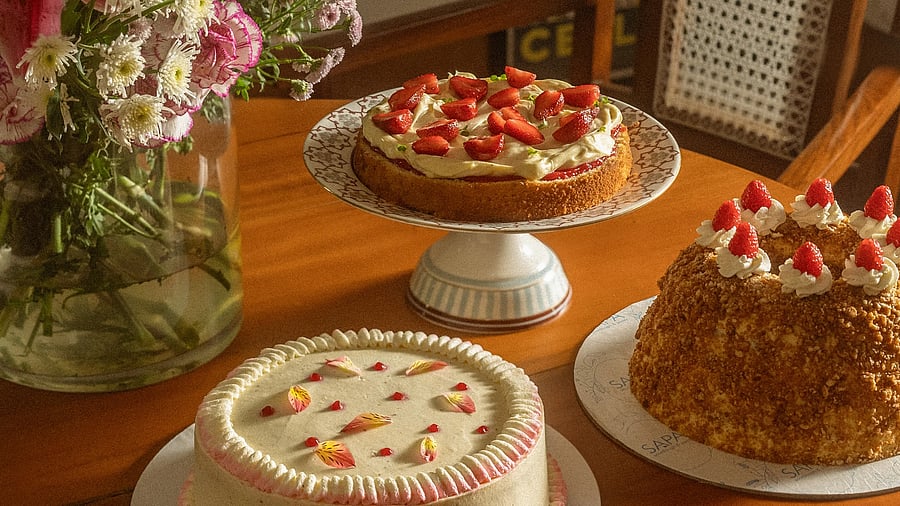
Lambeth-style piping and delicate buttercream flowers exude timeless elegance in SAPA Bakery’s creations.
Credit: Special arrangement
In an era of sleek, minimalist cake designs, the ornate and sentimental charm of vintage cakes is making a comeback. Before fondant-covered and glazed desserts took over, these cakes — often called Lambeth cakes — were the stars of celebrations. Defined by their piped rosettes, scalloped edges, and pastel hues, they evoke the joy of 1990s birthday parties and bakery shelves adorned with cherries and frosting.
Now, they’re back in vogue, not just in the West but also in Karnataka, with Instagram-worthy creations reigniting a collective nostalgia. Bakers in Bengaluru and across the state are recreating these cakes, merging classic visuals with both old-school and experimental flavours.
The Lambeth design
Originating in early 20th-century Britain, the Lambeth style is characterised by intricate piping, including lacework, swags, and floral rosettes, all requiring exceptional patience and skill. Though often replaced in recent decades by fondant or rustic styles, its return is being celebrated for both its aesthetic and emotional appeal.
Kriti Rao, dentist and founder of Sweettooth Patisserie, captures the essence of this revival: “It’s like making a bouquet on a cake — fun and super aesthetic. I started with simple swirls and now do realistic floral piping.”
Karnataka’s cake scene
Vintage cake visuals never truly disappeared in Karnataka. Iconic Bangalore bakeries like Iyengar’s long featured cream cakes with piped borders and frosting roses, an unspoken nod to the Lambeth style. For many, these designs bring warmth and familiarity.
“Vintage cakes evoke nostalgia and a sense of comfort,” says Raksha Gowra, co-founder and Head Baker at House of Sapora. “They’ve also gone viral online in the last two years, thanks to influencers.”
Bakers like Raksha, Kriti, Uthishta Kumar, and Dina Weber are now leading a movement that celebrates craft and memory. Pastel palettes, metallic beads, and hand-piped floral designs define their creations, along with adventurous flavour fusions.
Fusion of flavours
Modern Lambeth-style cakes in Karnataka go beyond visuals. They blend Eastern and Western ingredients — think gulab jamun or filter coffee infused into classic Western sponge cakes. “I’ve done cakes with rasmalai, mango-cardamom, even filter coffee,” says Kriti. “Cardamom with buttercream is surprisingly good. But chocolate and vanilla still rule.” Raksha incorporates Southeast Asian flavours like matcha, ube, pandan, and kaya jam — ingredients inspired by her travels — giving these cakes a contemporary, global touch.
Sentimental celebrations
Although vintage cakes are most associated with birthdays, they’ve expanded into weddings, baby showers, and anniversaries. Their handmade details make them especially fitting for sentimental occasions. “Clients often show us photos of their childhood cakes and ask us to recreate them,” Raksha shares. “It’s a way of reliving those memories.”
The emotional pull is real. Archana Achal, a communications professional, recalls Iyengar’s Black Forest cakes as part of her childhood winters. “That’s the only cake I remember craving every year. Vintage cakes remind me of birthdays with my family, of homes with lace tablecloths...”
Art over automation
In a digital age where design can be automated, Lambeth cakes stand out for their handcrafted quality. Some cakes take hours to complete, with multi-layered piping that demands precision and care.
“People want that human touch,” says pastry chef Uthishta Kumar. “Social media helped bring these ornate cakes back. One client brought in a photo of her first birthday cake. She was getting married and wanted the same design for her last birthday at home. That emotional connection is everything.”
Masterclasses and online tutorials have made it easier for young bakers to learn these near-forgotten techniques. But it’s not without challenges.
Behind the buttercream
Creating and transporting Lambeth cakes is no small feat. The delicate layers and thick buttercream make them sensitive to weather, travel, and health preferences.
“Transporting this type of cake is one of the biggest challenges as it cannot be frozen, and will start to split due to the light layers of the cream,” says Dina Weber, founder of SAPA.
Kriti agrees: “In summer, buttercream turns to liquid. And we’ve had to tweak the recipe to make it lighter for health-conscious clients.”
Still, despite their higher price, customers continue to choose Lambeth cakes for their emotional and visual value.
More than a trend
While it may have started as an online trend, the Lambeth revival is finding deeper meaning through storytelling, cultural adaptation, and artistry. “For Gen Z, it’s aesthetic. For millennials, it’s nostalgia,” says Raksha. “Everyone wants a birthday cake that feels like home.” Dina adds, “Trends fade. But when a cake carries memory and flavour, it becomes timeless.”
A sweet future
What’s old doesn’t have to be outdated. The Lambeth design is evolving, not disappearing. In Karnataka, the fusion of global and regional styles continues to shape its identity. “It’s about balancing the new with the familiar,” says Uthishta. As cake artistry evolves, vintage cakes serve as a reminder that craftsmanship, emotion, and flavour never go out of style.